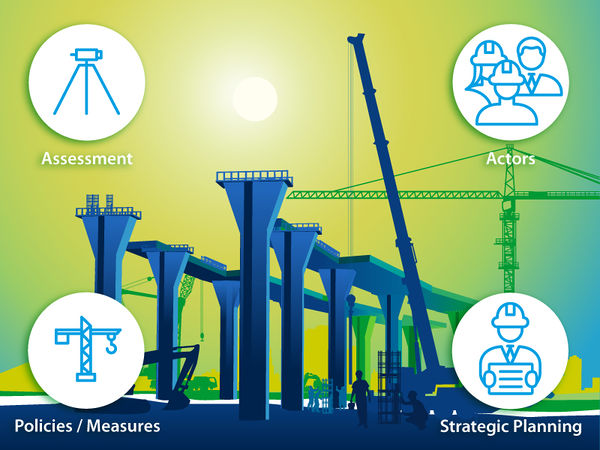Difference between revisions of "SE4Jobs Toolbox - Assessment"
From energypedia
***** (***** | *****) |
***** (***** | *****) |
||
| Line 58: | Line 58: | ||
*RE and EE development is most likely to create jobs abroad, as it mostly benefits foreign companies that are already active in these markets. Rather than benefiting companies at home, it would increase employment in other more established countries with stronger export potential. | *RE and EE development is most likely to create jobs abroad, as it mostly benefits foreign companies that are already active in these markets. Rather than benefiting companies at home, it would increase employment in other more established countries with stronger export potential. | ||
| − | Job creation in the RE and EE sectors would be offset by job losses in conventional sectors or lead to opportunity costs that result in negative net effects. To counter such arguments, it is extremely important to assess the actual potential of RE and EE to create positive net effects based on local value added and employment.<ref> | + | Job creation in the RE and EE sectors would be offset by job losses in conventional sectors or lead to opportunity costs that result in negative net effects. To counter such arguments, it is extremely important to assess the actual potential of RE and EE to create positive net effects based on local value added and employment.<ref>IRENA, 2015c, provides a thorough overview on the methodology used in the assessment of employment effects of RE. </ref> Such assessments not only help decision-makers to justify measures to support these sectors in general; they also help to determine which aspects (technologies, parts of the value chain, etc.) are likely to produce the greatest benefits and returns on investments. |
When assessing existing capacities for or the potential positive effects of expanding RE/EE, it is essential to use appropriate and reliable data and methods. The next section outlines different data sources and methods that you can use to assess the socio-economic effects of expanding RE/EE, and illustrates them with successful cases of how they have been used around the world. | When assessing existing capacities for or the potential positive effects of expanding RE/EE, it is essential to use appropriate and reliable data and methods. The next section outlines different data sources and methods that you can use to assess the socio-economic effects of expanding RE/EE, and illustrates them with successful cases of how they have been used around the world. | ||
| Line 131: | Line 131: | ||
'''[Table: Employment factor estimates for different RE technologies. Source: IRENA, 2013, p. 42. Please see the original source for references to the data sources presented in the table above. INSERT TABLE]''' | '''[Table: Employment factor estimates for different RE technologies. Source: IRENA, 2013, p. 42. Please see the original source for references to the data sources presented in the table above. INSERT TABLE]''' | ||
| + | <br/><br/>'''[Figure: Direct and indirect jobs per deployment phase (in jobs/MW) for different RE technologies based on minimum, median and maximum values for employment factors in the available literature. INSERT FIGURE - Source: Cameron and van der Zwaan, 2015<ref>“O&M” stands for the operation and maintenance of RE technologies.</ref>.]''' | ||
| − | + | '''Economic models''' Quantitative data can also be gathered via '''economic models'''. These can be used to compare different investment scenarios (and policies that encourage such investments) in RE and EE, as well as to assess their impact on (domestic) economic parameters such as value creation and employment. Different types of models are available and are classified according to their methodology: | |
| − | |||
| − | '''Economic models''' | ||
| − | Quantitative data can also be gathered via '''economic models'''. These can be used to compare different investment scenarios (and policies that encourage such investments) in RE and EE, as well as to assess their impact on (domestic) economic parameters such as value creation and employment. Different types of models are available and are classified according to their methodology: | ||
*'''Computable General Equilibrium (CGE) models'''calculate demand, supply and the prices for clearing markets after a ‘disturbance’ (e.g. the introduction of a policy). A CGE model can be disaggregated into different sectors, depending on the availability of data. | *'''Computable General Equilibrium (CGE) models'''calculate demand, supply and the prices for clearing markets after a ‘disturbance’ (e.g. the introduction of a policy). A CGE model can be disaggregated into different sectors, depending on the availability of data. | ||
*'''Partial market models'''calculate the price of a single good (e.g. electricity) and, based on this, estimate impacts on demand and supply (including employment) along the value chain. | *'''Partial market models'''calculate the price of a single good (e.g. electricity) and, based on this, estimate impacts on demand and supply (including employment) along the value chain. | ||
| − | *'''Econometric models'''show the structure of the economy and calculate time series, rather than specific future states of the economy. Furthermore, they are capable of representing structural changes in and across sectors as a result of a policy, innovation or investment. Thus, they are particularly helpful for estimating any synergies and trade-offs from the expansion of RE and EE, and in identifying the actors that stand to benefit or lose out | + | *'''Econometric models'''show the structure of the economy and calculate time series, rather than specific future states of the economy. Furthermore, they are capable of representing structural changes in and across sectors as a result of a policy, innovation or investment. Thus, they are particularly helpful for estimating any synergies and trade-offs from the expansion of RE and EE, and in identifying the actors that stand to benefit or lose out [[[SE4Jobs_Toolbox_-_Trade-offs|see section on synergies and trade-offs]]]. However, developing and running econometric models is more demanding in terms of the data required – time series data are needed, while CGE models require only discrete data. |
*'''System dynamics'''is another modelling approach. The economy is represented in stocks (typically assets) and flows between these stocks (e.g. investments or income). Such models are also used to explore feedback loops. | *'''System dynamics'''is another modelling approach. The economy is represented in stocks (typically assets) and flows between these stocks (e.g. investments or income). Such models are also used to explore feedback loops. | ||
*'''Microsimulations''' can be used to analyse the impacts of policies on the income of individual households. These are typically based on a range of different indicators, such as a household’s income, socio-economic status, consumption patterns, and demographic data. These kinds of models have demanding data requirements, but can yield useful analysis on the distributional impacts of many different policies. | *'''Microsimulations''' can be used to analyse the impacts of policies on the income of individual households. These are typically based on a range of different indicators, such as a household’s income, socio-economic status, consumption patterns, and demographic data. These kinds of models have demanding data requirements, but can yield useful analysis on the distributional impacts of many different policies. | ||
| Line 149: | Line 147: | ||
<span style="color:#336699">''The model compared four different scenarios – two versions of ‘business as usual’ and two versions of a ‘green investment’ scenario “assum[ing] an active government intervention in the identified four sectors in order to encourage shifts towards low carbon, resource-efficient and pro-employment development” ('''UNEP, 2013, p. 28)'''. The comparison of the four scenarios using the system-dynamics T21 model showed that the green investment scenario in which an additional 2% of GDP was invested in the green economy led to the highest employment gains in the South African economy (28.3 million jobs in 2030, compared to fewer than 28 million jobs in the BAU scenarios). The study provides an example of an advanced system dynamics model being applied to a country to estimate the medium and long-term economic and employment effects of a green economy. Its key findings support policymakers arguing for active investments to accelerate the transition to a green economy.''</span> | <span style="color:#336699">''The model compared four different scenarios – two versions of ‘business as usual’ and two versions of a ‘green investment’ scenario “assum[ing] an active government intervention in the identified four sectors in order to encourage shifts towards low carbon, resource-efficient and pro-employment development” ('''UNEP, 2013, p. 28)'''. The comparison of the four scenarios using the system-dynamics T21 model showed that the green investment scenario in which an additional 2% of GDP was invested in the green economy led to the highest employment gains in the South African economy (28.3 million jobs in 2030, compared to fewer than 28 million jobs in the BAU scenarios). The study provides an example of an advanced system dynamics model being applied to a country to estimate the medium and long-term economic and employment effects of a green economy. Its key findings support policymakers arguing for active investments to accelerate the transition to a green economy.''</span> | ||
| − | '''Firm surveys''' | + | '''Firm surveys''' Innovations, investments and markets for energy efficiency technologies are particularly hard to trace. This is because the technologies and their applications are not specific to a particular sector, and are instead widely dispersed across the economy. To gather data on innovation, investments and employment related to energy efficiency, '''surveys''' '''of''' '''firms''' are a valuable source for estimating markets, and their prospects and impacts. |
| − | Innovations, investments and markets for energy efficiency technologies are particularly hard to trace. This is because the technologies and their applications are not specific to a particular sector, and are instead widely dispersed across the economy. To gather data on innovation, investments and employment related to energy efficiency, '''surveys''' '''of''' '''firms''' are a valuable source for estimating markets, and their prospects and impacts. | ||
<span style="color:#336699">'''''Report: “Decent Work in the Green Economy. Business Cases from Turkey”'''''</span> | <span style="color:#336699">'''''Report: “Decent Work in the Green Economy. Business Cases from Turkey”'''''</span> | ||
| Line 158: | Line 155: | ||
=== Challenges in implementing the issue of assessing existing capacities and potentials <span style="line-height: 21px"><span class="mw-customtoggle-title6" style="font-size:small; font-weight: bold; display:inline-block; float:center; color: blue"><span class="mw-customtoggletext">'''[Expand]'''</span></span></span><br/> === | === Challenges in implementing the issue of assessing existing capacities and potentials <span style="line-height: 21px"><span class="mw-customtoggle-title6" style="font-size:small; font-weight: bold; display:inline-block; float:center; color: blue"><span class="mw-customtoggletext">'''[Expand]'''</span></span></span><br/> === | ||
<div id="mw-customcollapsible-title6" class="mw-collapsible mw-collapsed"> | <div id="mw-customcollapsible-title6" class="mw-collapsible mw-collapsed"> | ||
| − | *'''The time and resources required to build capacity'''''.'' <br/>Assessments are based on data, often using elaborate models and time series. Therefore, missing data sets cannot be replaced easily and building capacities for such assessments must be viewed as a long-term challenge that concerned actors should approach in collaboration with national statistical offices, private sector representatives and dedicated scientific institutions. | + | *'''The time and resources required to build capacity'''''.''<br/>Assessments are based on data, often using elaborate models and time series. Therefore, missing data sets cannot be replaced easily and building capacities for such assessments must be viewed as a long-term challenge that concerned actors should approach in collaboration with national statistical offices, private sector representatives and dedicated scientific institutions. |
| − | *'''Choosing the right methodology and adapting it to the local context'''''.'' <br/>There are a variety of methodologies available and each has its strengths and weaknesses, depending on the purpose for and context in which they are used. International organizations such as UNEP and the ILO have been developing methodologies for assessments that can be used in developed and developing countries. However, the adaption of methodologies from other countries can lead to significant problems. For example, studies conducted on South Africa have shown that the employment factors in RE technologies estimated for industrial countries were inadequate for correctly estimating employment effects in the South African context – illustrating the need to meticulously adapt methodologies to local contexts. | + | *'''Choosing the right methodology and adapting it to the local context'''''.''<br/>There are a variety of methodologies available and each has its strengths and weaknesses, depending on the purpose for and context in which they are used. International organizations such as UNEP and the ILO have been developing methodologies for assessments that can be used in developed and developing countries. However, the adaption of methodologies from other countries can lead to significant problems. For example, studies conducted on South Africa have shown that the employment factors in RE technologies estimated for industrial countries were inadequate for correctly estimating employment effects in the South African context – illustrating the need to meticulously adapt methodologies to local contexts. |
</div> | </div> | ||
| style="width: 5px" | <br/> | | style="width: 5px" | <br/> | ||
| Line 184: | Line 181: | ||
{{Re-activate Footer}} __NOTITLE__<br/> | {{Re-activate Footer}} __NOTITLE__<br/> | ||
| − | |||
| − | |||
Revision as of 14:29, 17 November 2017
SE4Jobs Toolbox – Laying the foundations for a sustainable development
ToolsPRODUSE EQuIP CADRE Interactive AILEG HELIO ELMA |
What is the issue assessment of existing capacities and potentials about? [Expand]
Why is such an assessment important for the expansion of RE and EE? [Expand]
What are key questions for addressing the issue of assessing existing capacities and potentials? [Expand]
How can the issue of assessing existing capacities and potentials be addressed? [Expand]
Practical aspects of the issue and good practice examples [Expand]
Challenges in implementing the issue of assessing existing capacities and potentials [Expand]
|
Good Practices
Brazil China India Mexico South Africa Turkey |
Reference
- ↑ IRENA, 2015c, provides a thorough overview on the methodology used in the assessment of employment effects of RE.
- ↑ See http://resourceirena.irena.org/gateway/dashboard/
- ↑ See https://www.wec-indicators.enerdata.eu/
- ↑ The Global Atlas for Renewable Energy is available at http://irena.masdar.ac.ae/
- ↑ “O&M” stands for the operation and maintenance of RE technologies.
|
This article is part of the RE-ACTIVATE project. RE-ACTIVATE “Promoting Employment through Renewable Energy and Energy Efficiency in the MENA Region” is implemented by the Deutsche Gesellschaft für Internationale Zusammenarbeit (GIZ) GmbH on behalf of the German Ministry for Economic Cooperation and Development (BMZ). |





















